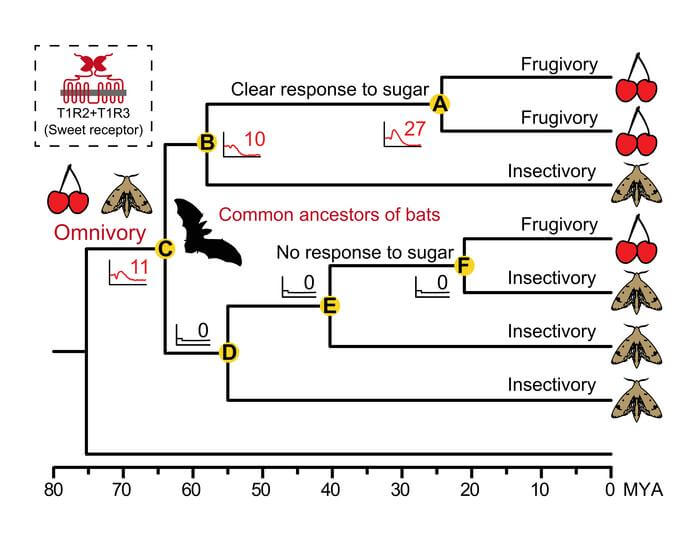The origins of powered flight and laryngeal echolocation in bats are widely cited as evidence that ancestral bats evolved as insectivores. Moreover, others have hypothesis that suggesting early bats were diurnal herbivores and that insectivory emerged secondarily for protein supplementation, which suggests modern frugivorous and nectarivorous bats might have retained ancestral adaptations, rather than undergone derived specializations. Direct evidence relating to the diets of ancestral bats is lacking.
Taste is closely linked to diet, and the sweet taste is particularly tied to the consumption of carbohydrate. The sweet taste receptor is formed by a dimer of Tas1r2 and Tas1r3, encoded by the Tas1r2 and Tas1r3 genes, respectively. In a previous study, both in vivo and in vitro functional experiments indicated that frugivorous species from both suborders of bats can sense natural sugars, whereas insectivorous species cannot.
To obtain insights into early evolution of bats, this study assesses whether ancestral bats were able to sense natural sugars, by resurrecting and measuring the functional properties of ancient proteins from six ancestral linages. The sweet receptors of the common ancestors of all extant bats, Yinperochiroptera, and Pteropodidae showed clear responses to natural sugars.
Functional assays of mismatched sweet receptors indicated that Tas1r2 is responsible for the loss of sweet taste in the ancestor of Yangochiroptera, and both Tas1r2 and Tas1r3 have resulted in the regain of the sweet taste in a New World fruit bat.
Two sets of protein sequences respectively resurrected by the amino acid model and the codon model showed the same trend in functional assays. Clear responses to an artificial sweetener as a positive control and similar equivalent expression levels of Tas1r2 and Tas1r3 confirmed that the heterologous expression system worked properly.
In summary, these findings provide the first evidence that the ability to sense natural sugars was present in the common ancestors of extant bats. Based on the correspondence between taste and diet in extant bats, early bats were suggested as omnivorous, feeding on a mixture of fruits and insects, and the ability to preceive sweetness has been retained throughout the evolutionary history of Old World fruit bats. The omnivorous diet of the common ancestor of bats challenges the common view that bats evolved flight and echolocation for hunting insects. Instead, it raises the possibility that the first bats hunted for insects and fruit without echolocation.
“This is an interesting study that went an additional step in inferring ancestral phenotypes from ancestral genotypes.,” says Professor Jianzhi George Zhang, the former President of Society for Molecular Biology and Evolution and Fellow of the American Association for the Advancement of Science, an evolutionary geneticist at the University of Michigan. “In this work, the authors inferred the dietary preference of the common ancestor of all extant bats by experimentally confirming the functions of inferred ancestral taste receptor genes, rendering their phenotypic inference more trustworthy. Because the diet of ancestral bats is hypothesized to be linked with the evolution of bat flight and echolocation, this study will stimulate investigations of the origin of bats and their unique biology.” Zhang says.
“This is an exciting new study where the authors reconstructed the taste receptors from ancestral bats using evolutionary methods to uncover how bat’s feeding behaviours evolved,” says Professor Emma Teeling, the member of Royal Irish Academy, a zoologist at the University College Dublin, Ireland. “One particularly interesting observation is that potentially New World fruit-feeding bats have evolved a different way to taste natural sugars, which would provide a new avenue for mammalian sensory biology. This study is an exciting example of the use of functional genomics to link genotype and phenotype together, giving us a unique insight into the evolution of bats’ unique sensory biology not possible before.” Teeling adds.
See the article:


